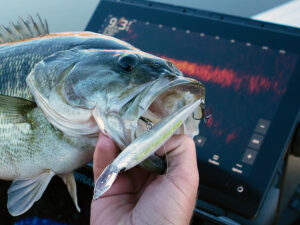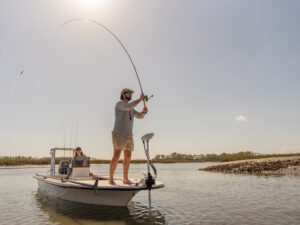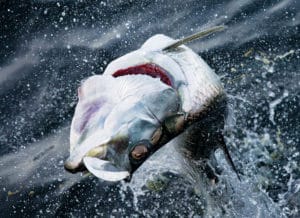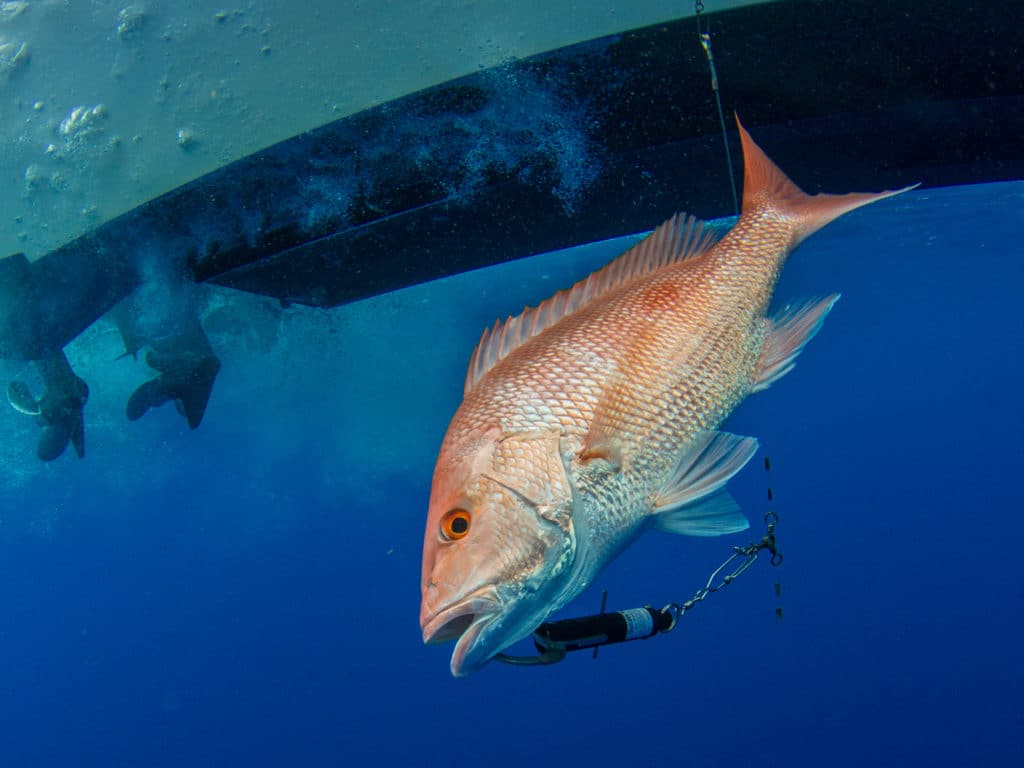
September 2013 marked a drastic change in Gulf of Mexico fishing regulations when the region’s federal fishery managers decided that venting tools were no longer mandatory on boats targeting bottom species such as snappers and groupers. But why? No one wants to waste a bottomfish by releasing it with distended stomach and intestines, bulging eyes and bloated belly, just to watch it struggle and perish at the surface.
The Gulf of Mexico Fishery Management Council wasn’t neglecting its duty to conserve bottom species. Instead, the change happened partly because NOAA tagging studies for Pacific rockfish found a better method to combat barotrauma: fish descenders. Fish-descender devices don’t require punctures with a hollow-needle tool, but instead attach to the fish’s mouth and take it back down to the depths using a weight.
“We encountered survival rates of up to 85 percent with rockfish [released] using fish-descender devices,” says Nick Wegner, an NOAA fisheries research biologist based in La Jolla, California. “We tagged the rockfish with an acoustic transmitter that pinged acceleration and depth changes to nearby receivers, demonstrating the fish were alive and active.”
Whether fishing in the Pacific, Gulf or Atlantic, most offshore anglers catch fish with signs of barotrauma. The symptoms show when a fish that’s deep is brought to the surface quickly, causing gas inside its body to expand with the water’s decreasing atmospheric pressure.
“The gases in the swim bladder — what fish use to maintain neutral buoyancy — expand too quickly, pushing on the stomach, eyes and other organs,” says Wegner. “Descending the fish to depths allows the gas to recompress, taking pressure off the organs.”
Releasing Deepwater Fish
Starting as shallow as 60 feet, catch-and-release fishermen will likely catch fish that need help getting back down. One option is to make your own tool: a “fish elevator” made up of a milk crate, rope and dive weights.
Attach one weight to each side of the crate with zip ties, and add a line to the bottom. To use the device, place the fish inside the crate and set the crate overboard so the open side falls toward the water, all the while making sure the fish stays inside the crate. Then let out enough line to get the fish to the proper depth; stop and allow the fish to swim free.
The fish elevator isn’t a bad option for smaller fish in calm, shallow seas, but commercial products that are less cumbersome and require no tinkering out of the package are readily available. Four main fish descenders on the market each excel in different scenarios. A dedicated boat rod with a fish-descender device should be rigged and ready whenever fishing offshore for bottom species.
Available Fish-Descender Devices
Blacktip’s Catch & Release Recompression Tool
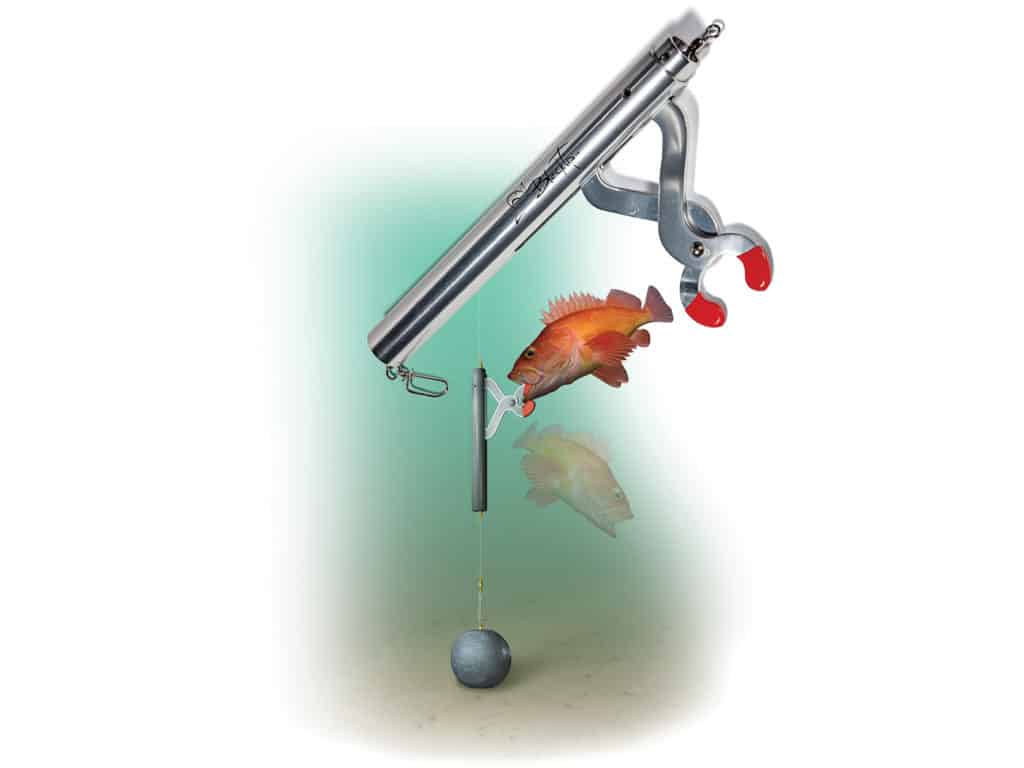
Blacktip’s Catch & Release Recompression Tool employs a heavy weight to return the fish to depth, says Tom Raftican, of the Sportfishing Conservancy, an organization that holds workshops to teach best fish-release practices.
“The weight holds the tool’s jaws together, clamping around the fish’s jaw,” he says. “The size of weight needed depends on the size of fish, but a 3-pound ball is a good place to start. The angler lowers the device until the weight hits ocean bottom, opening the tool’s jaw and releasing the fish.”
Available at West Marine locations, the Blacktip recompression tool is built from anodized aluminum, brass swivels and pins, and coated jaw tips — plus the device is spring-loaded to automatically release. One limiting factor is that the device requires an angler to deploy the fish, tool and weight completely to the seafloor, which can be quite burdensome when fishing in waters with lots of current or depths that pass a couple hundred feet.
RokLees Descender Device by EcoLeeser
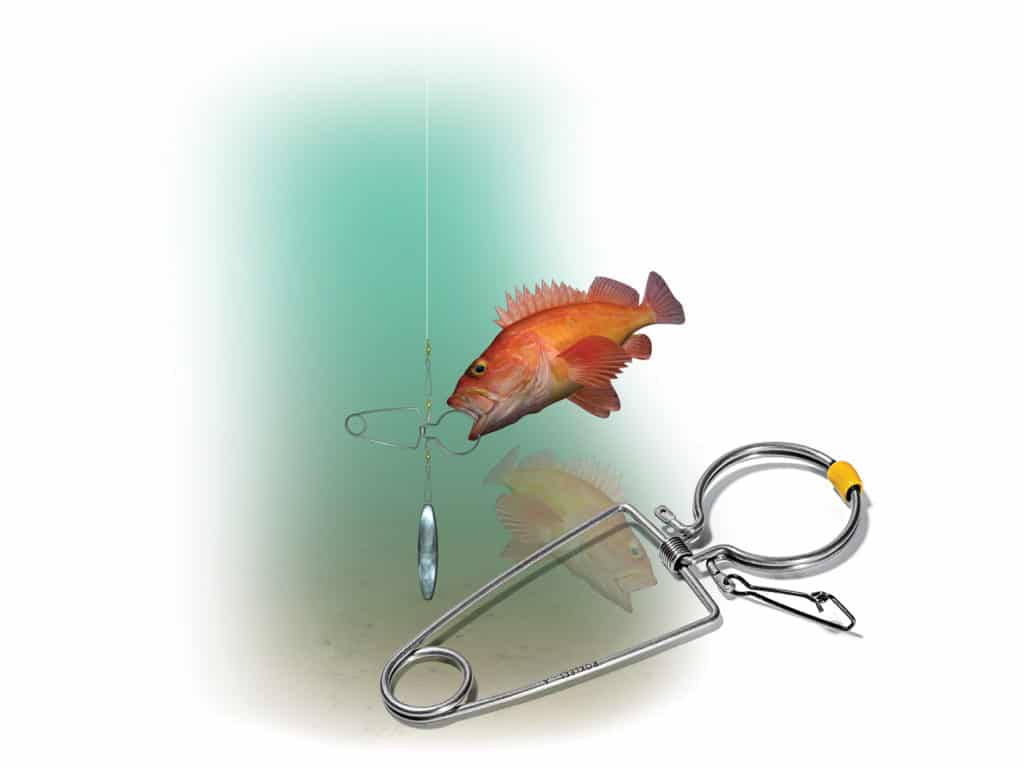
Remember doing experiments in chemistry class?
The RokLees descender device by EcoLeeser works like a test-tube holder. Instead of holding onto a tube, the jaws grab a fish’s lower lip. The main line of a fishing rod (at least 100 yards of 65- to 80-pound braid) ties to the upper tab, and a weight attaches to the lower tab. Make sure each tab connects to a heavy-duty swivel before attaching the line or weight. Descend the fish to at least one-third of the depth where it was caught, and then jerk up the rod once or twice to release the fish, says Randy Hupp, owner of EcoLeeser.
“It takes 1 pound of weight to get a 3-pound fish down, and 3 pounds to get a 10-pound fish down,” says Hupp. Add more weight to the lower lobe and the opposing arm to handle heavier fish. Too much weight on the lower lobe alone will pry the jaws open, releasing the fish prematurely.
“This device has made a clear impact on our local fishery here in San Diego,” he says. “Because people are using these devices, depths from 300 to 360 feet were opened for fishermen to target rockfish.”
SeaQualizer
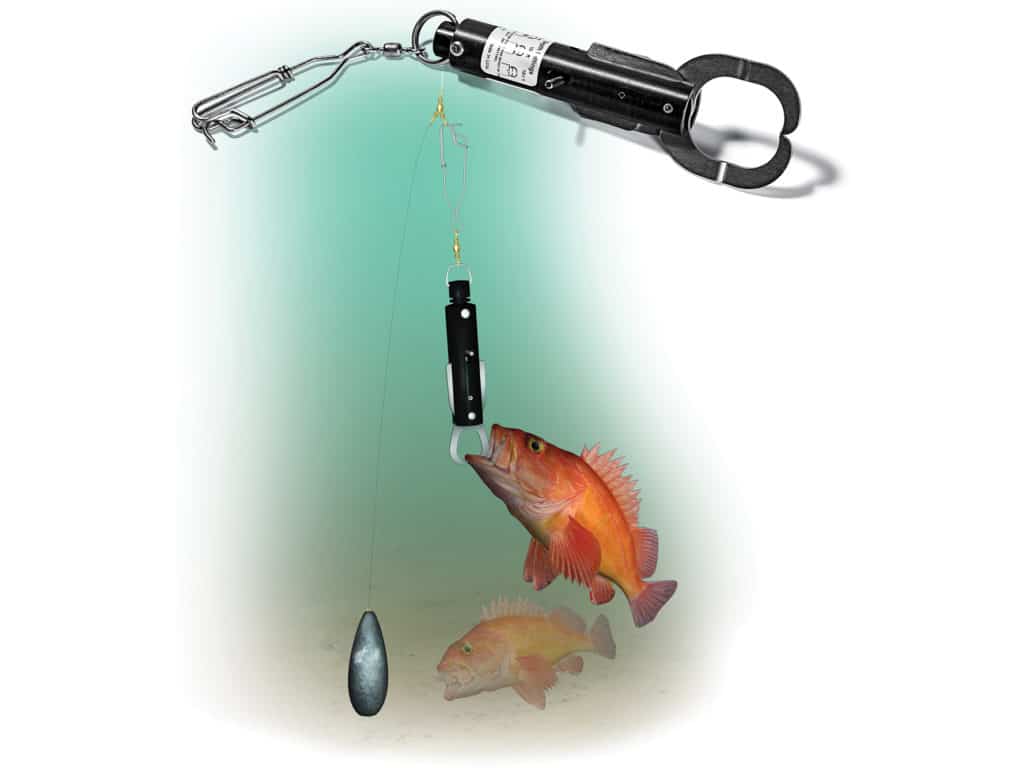
By far the most sophisticated of today’s fish-descender devices, the SeaQualizer utilizes pressure-activated release settings to unclip the jaws from a fish’s mouth when it reaches a certain depth. The original SeaQualizer has release settings for depths of 50, 100 and 150 feet; the shallow SeaQualizer’s settings are 30, 50 and 70 feet; and deepwater SeaQualizer settings handle deployments at 100, 200 and 300 feet.
“Each depth setting is selected by turning the plug on the back of the device,” says Jeffrey Liederman, owner of SeaQualizer. “It can be rigged in several ways — either from a designated-release rod and reel, retrieval hand line, downrigger, or attached to your bottomfishing line.”
Using the SeaQualizer, there is no way to release a fish prematurely at the wrong depth. You don’t have to make a guess at the proper depth or jerk the rod to release the fish.
“When the device reaches the pressure associated with the depth it’s set for, the jaws open and the fish swims off,” says Liederman. “I recommend having a variety of weights ready to clip to your rig, but usually a 2- to 3-pound stick lead works for most applications and stores well on the boat.”
Shelton Fish Descender
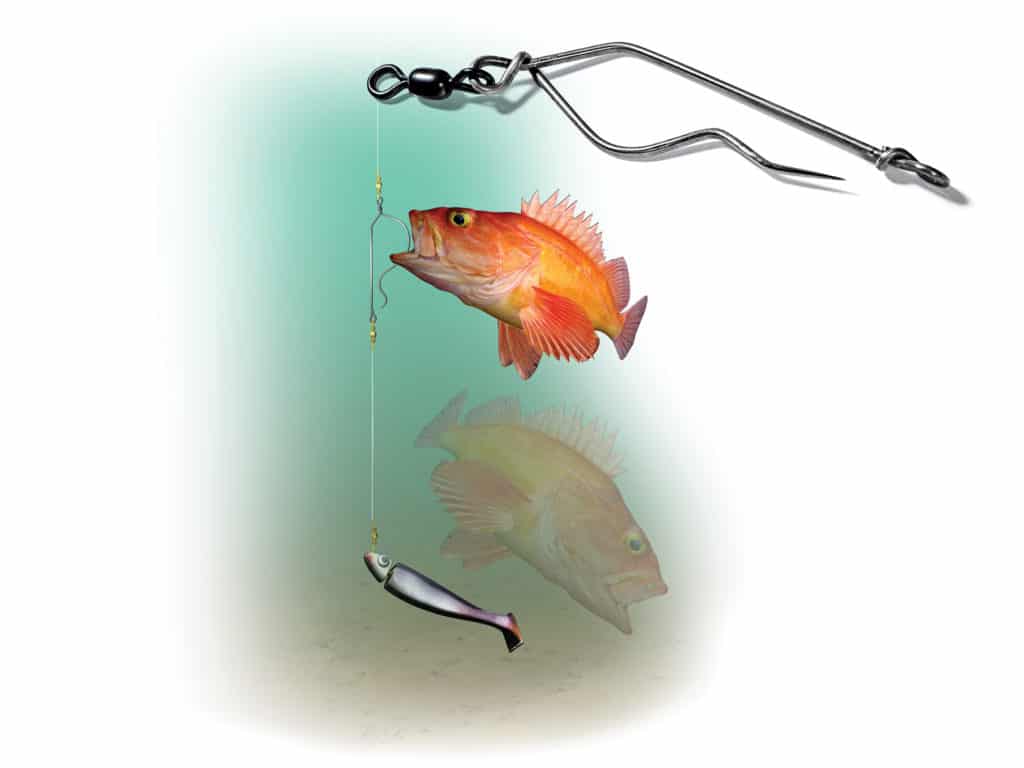
The Shelton Fish Descender is a simple S-shaped wire hook clip that ties directly in line to a bottom rig, says Bill Shelton, owner of Shelton Products. “The hook pokes through the fish’s lower lip, keeping the mouth slightly ajar to allow water across the gills; a heavy weight at the terminal end of the rig pulls the fish down.”
Because the wire hook is tied to the line pointing down, bloated fish must be hooked and placed in the water before the terminal weight is tossed out. This prevents a fish from slipping off the SFD. Another option is to rig a sliding egg sinker above the device and place it in the water first, or stick your rod tip in the water first, forcing the S-hook upward until the fish descends.
The Shelton descender is great for smaller fish such as rockfish or Atlantic black sea bass because it’s able to handle more than one fish at a time. Once the fish reach a desired depth, quickly snap the line upward to release, says Shelton. Because the SFD is slim in design, it doesn’t need its own dedicated rod. A heavy jig can replace the bottom weight, or a two-hook rig can be tied above the device — this allows an angler to recompress fish and catch new fish on the same drop.
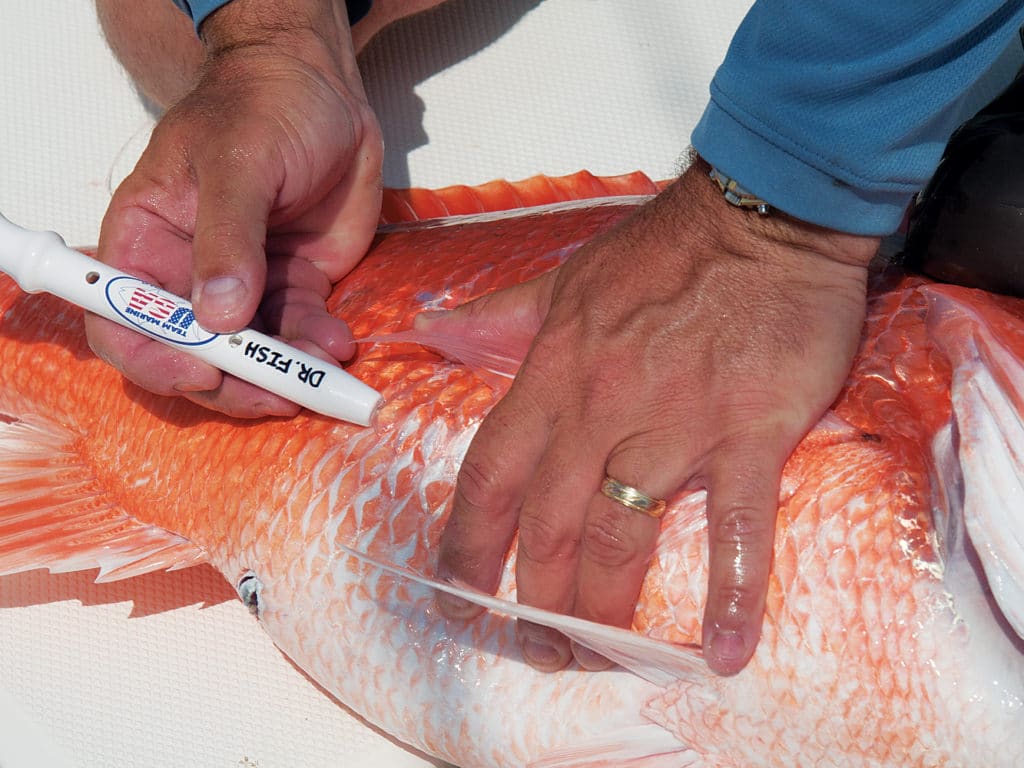
No More Needles
Practice Makes Perfect
Whether it’s a bocaccio rockfish, red snapper or gag grouper, return the fish to the water as soon as possible. “Less than three minutes maximizes the chance of survival,” says Wegner. “Getting the fish back to the depth it was hooked, or even all the way to the bottom, leads to the highest survival rates. Even lowering them halfway down is often successful.”
Deepwater release tools help bolster bottomfish numbers, open doors for increased season lengths, and even unlock potential offshore spots that were once closed because of catch mortality. No matter the device used, healthy releases benefit all fishermen.

